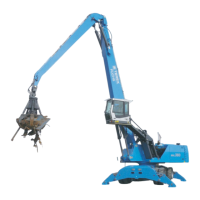5 WORK OPERATION
5.14 MHL380 D
5.1.13 Boom float function (optional)
The "Boom float function" option requires the
use of hose rupture safety valves on the lift
cylinders.
The float function assists the machine operator
when goods are being unloaded from ships.
When the load is being taken up, unintention-
al contact can occur between the grab tips
and the ship's floor due to the closing move-
ment of the grab. This can damage the ship's
floor. Additionally, the grab tines are limited in
their movement. The closing process is de-
layed, the work cycles take more time and the
transfer capacity drops.
The solution to this problem is provided by a
float function, which separates the grab from
the floor during closing by automatically lifting
the boom.
The function principle is based on the meas-
urement of the ground-based oil pressure in
the lift cylinders. When the grab closes, the
tips of the tines support themselves on the
ship's floor. In doing so, the lift cylinders are
relieved at the base and the pressure de-
creases.
When a defined lower pressure threshold is
reached, the "Raise boom" function will be
executed automatically. (The "Lower boom"
movement with control lever is disabled.)
As soon as the oil pressure in the lift cylinders
reaches a preset upper threshold, the auto-
matic lifting motion will be disabled again and
the "Lower boom" work function will be ena-
bled.
This will automatically keep the grab "floating"
above the surface (for example, above the
ship's floor).
To optimize the float function when working in
close range (boom steep, dipperstick retract-
ed) or when working in remote range (boom
flat, dipperstick extended), two different value
pairs are available for the lower pressure
threshold ("ON pressure") and the upper
threshold ("OFF pressure"). These threshold
values can be set in the service menu.

